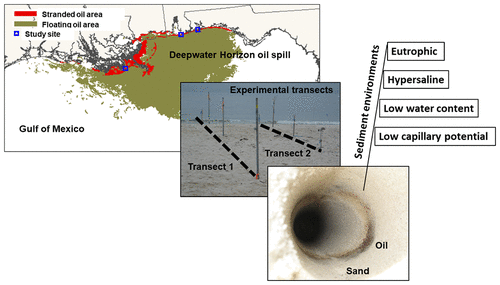当前位置:
X-MOL 学术
›
Environ. Sci. Technol.
›
论文详情
Our official English website, www.x-mol.net, welcomes your
feedback! (Note: you will need to create a separate account there.)
Hypersaline Pore Water in Gulf of Mexico Beaches Prevented Efficient Biodegradation of Deepwater Horizon Beached Oil
Environmental Science & Technology ( IF 10.8 ) Pub Date : 2021-10-07 , DOI: 10.1021/acs.est.1c02760 Xiaolong Geng 1 , Charbel Abou Khalil 1 , Roger C Prince 2 , Kenneth Lee 3 , Chunjiang An 4 , Michel C Boufadel 1
Environmental Science & Technology ( IF 10.8 ) Pub Date : 2021-10-07 , DOI: 10.1021/acs.est.1c02760 Xiaolong Geng 1 , Charbel Abou Khalil 1 , Roger C Prince 2 , Kenneth Lee 3 , Chunjiang An 4 , Michel C Boufadel 1
Affiliation

|
The 2010 Deepwater Horizon (DWH) blowout released 3.19 million barrels (435 000 tons) of crude oil into the Gulf of Mexico. Driven by currents and wind, an estimated 22 000 tons of spilled oil were deposited onto the northeastern Gulf shorelines, adversely impacting the ecosystems and economies of the Gulf coast regions. In this work we present field work conducted at the Gulf beaches in three U.S. States during 2010–2011: Louisiana, Alabama, and Florida, to explore endogenous mechanisms that control persistence and biodegradation of the MC252-oil deposited within beach sediments as deep as 50 cm. The work involved over 1500 measurements incorporating oil chemistry, hydrocarbon-degrading microbial populations, nutrient and DO concentrations, and intrinsic beach properties. We found that intrinsic beach capillarity along with groundwater depth provides primary controls on aeration and infiltration of near-surface sediments, thereby modulating moisture and redox conditions within the oil-contaminated zone. In addition, atmosphere–ocean–groundwater interactions created hypersaline sediment environments near the beach surface at all the studied sites. The fact that the oil-contaminated sediments retained near or above 20% moisture content and were also eutrophic and aerobic suggests that the limiting factor for oil biodegradation is the hypersaline environment due to evaporation, a fact not reported in prior studies. These results highlight the importance of beach porewater hydrodynamics in generating unique hypersaline sediment environments that inhibited oil decomposition along the Gulf shorelines following DWH.
中文翻译:

墨西哥湾海滩的高盐度孔隙水阻止了深水地平线搁浅油的有效生物降解
2010 年深水地平线 (DWH) 井喷向墨西哥湾释放了 319 万桶(43.5 万吨)原油。在洋流和风的推动下,估计有 22 000 吨溢油沉积在墨西哥湾东北部海岸线上,对墨西哥湾沿岸地区的生态系统和经济产生不利影响。在这项工作中,我们介绍了 2010 年至 2011 年在美国三个州的海湾海滩进行的实地工作:路易斯安那州、阿拉巴马州和佛罗里达州,以探索控制沉积在海滩沉积物中的 MC252 油的持久性和生物降解的内源机制,深度达 50厘米。这项工作涉及 1500 多项测量,包括石油化学、碳氢化合物降解微生物种群、养分和溶解氧浓度以及固有的海滩特性。我们发现,固有的海滩毛细管作用以及地下水深度为近地表沉积物的曝气和渗透提供了主要控制,从而调节了油污染区域内的水分和氧化还原条件。此外,大气-海洋-地下水相互作用在所有研究地点的海滩表面附近创造了高盐度沉积物环境。受石油污染的沉积物保持接近或高于 20% 的水分含量,而且还富营养化和好氧,这一事实表明,石油生物降解的限制因素是由于蒸发而形成的高盐度环境,这一事实在先前的研究中没有报道。这些结果突出了海滩孔隙水流体动力学在产生独特的高盐度沉积物环境中的重要性,该环境抑制了 DWH 后海湾海岸线的石油分解。
更新日期:2021-10-19
中文翻译:

墨西哥湾海滩的高盐度孔隙水阻止了深水地平线搁浅油的有效生物降解
2010 年深水地平线 (DWH) 井喷向墨西哥湾释放了 319 万桶(43.5 万吨)原油。在洋流和风的推动下,估计有 22 000 吨溢油沉积在墨西哥湾东北部海岸线上,对墨西哥湾沿岸地区的生态系统和经济产生不利影响。在这项工作中,我们介绍了 2010 年至 2011 年在美国三个州的海湾海滩进行的实地工作:路易斯安那州、阿拉巴马州和佛罗里达州,以探索控制沉积在海滩沉积物中的 MC252 油的持久性和生物降解的内源机制,深度达 50厘米。这项工作涉及 1500 多项测量,包括石油化学、碳氢化合物降解微生物种群、养分和溶解氧浓度以及固有的海滩特性。我们发现,固有的海滩毛细管作用以及地下水深度为近地表沉积物的曝气和渗透提供了主要控制,从而调节了油污染区域内的水分和氧化还原条件。此外,大气-海洋-地下水相互作用在所有研究地点的海滩表面附近创造了高盐度沉积物环境。受石油污染的沉积物保持接近或高于 20% 的水分含量,而且还富营养化和好氧,这一事实表明,石油生物降解的限制因素是由于蒸发而形成的高盐度环境,这一事实在先前的研究中没有报道。这些结果突出了海滩孔隙水流体动力学在产生独特的高盐度沉积物环境中的重要性,该环境抑制了 DWH 后海湾海岸线的石油分解。











































 京公网安备 11010802027423号
京公网安备 11010802027423号